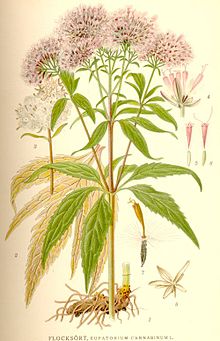Ordinary water stew
| Ordinary water stew | ||||||||||||
|---|---|---|---|---|---|---|---|---|---|---|---|---|

Common water feast ( Eupatorium cannabinum ) |
||||||||||||
| Systematics | ||||||||||||
|
||||||||||||
| Scientific name | ||||||||||||
| Eupatorium cannabinum | ||||||||||||
| L. |
The Ordinary Wasserdost ( Eupatorium cannabinum ), also water hemp and Kunhuta herb called, is a plant from the genus Wasserdost ( Eupatorium ) within the family of Compositae (Asteraceae).
description
Vegetative characteristics
The common water dost is a deciduous, perennial , herbaceous plant that reaches heights of 50 to 175 centimeters. The upright, unbranched and richly leafy stem is often reddish. Its opposite leaves are palmate and pinnate with three to seven leaflets, but rarely also undivided. The leaf margins are serrated lobed. A rhizome serves as a storage organ .
Generative characteristics
The flowering period extends from July to September. The dense, slightly arched, umbrella-like overall inflorescence contains numerous cup-shaped partial inflorescences. The blunt bracts are arranged like a roof tile. The bottom of the basket has no chaff leaves . The flower heads contain only four to six tubular flowers . The tubular flowers are fused from five pink, rarely white petals . The two branches of the style stick out from the flower tube .
The five-ribbed achenes are 2 to 3 millimeters long. The pappus consists of many bristles and is 3 to 5 millimeters long.
The number of chromosomes is 2n = 20.
ecology
The common water dost is a hemicryptophyte .
The pollination is effected by insects ( Entomophilie ). Butterflies and hoverflies in particular respond to the inflorescences. For the Russian bear , for example, the nectar of the water deast is an extremely important source of food in late summer. Self-pollination is also rarely observed.
The diaspores are the achenes, which are spread by the wind by means of the pappus ( anemochory ).
Site conditions
The common water dost thrives mostly in damp meadows, fallow meadows , on the banks of ditches and brooks or on the edges of forests and in fields. In Central Europe it is a character species of the Convolvulo-Eupatorietum from the Convolvulion Association, but also occurs in plant communities of Atropion.
The Wasserdost is a nitrification and moisture indicator.
Systematics and distribution
Eupatorium cannabinum was first published by Carl von Linné .
The common water dost is common throughout Europe, West Asia and North Africa. In North America and Australia it is a neophyte .
One can distinguish between two subspecies:
- Eupatorium cannabinum L. subsp. cannabinum : It occurs in Europe, West Asia and North Africa.
- Eupatorium cannabinum subsp. corsicum (Loisel.) P. Fourn. (Syn .: Eupatorium corsicum Loisel.): It occurs in France , Corsica , Sardinia and Italy .
Common names
For the common (or common) Wasserdost exist or existed also the other German-language trivial names : Alapkraut, Albdost, Albkraut ( Silesia ), Alpkraut ( Alsace , mentioned as early as 1482), Blauwetterkühl, Bolkenskruit, Bruchwurz (Silesia), Thunderbolt ( Lower Rhine , Westphalia ) Dosten ( Augsburg ), dragon herb ( Silesia), long sheaf, Gischklee ( Switzerland ), Grundheil, hemp herb (mentioned as early as 1482), Hertzlile, Hirschdost, Hirschgünsel (Silesia), deer clover, Hirtzklee (for example from Adam Lonitzer ), Königundkraut, Kunigkraut (Silesia), lamb's tail (Mark bei Belzig ), Leberbalsam (Silesia), brown liverwort, liver rust, Mannskraft, Mannsliebe, Ottig, red Ruhrkraut ( Austria ), wild Scarleye ( Middle Low German ), wild Scarleyge (Middle Low German), wild Scharleie (Middle Low German) , wild Scharlige (Middle Low German), jokes, Schlosskraut (Alsace), Schümpferblume (in the sense of lover's flower, Henneberg, Franconia ), wild same, hour weed t, Tosten (already mentioned in 1587), Tugendblume (Silesia), Veltsalway (Middle High German), Waterdoust, Wasserdost, water hemp ( St. Gallen in the Upper Rhine Valley , Swabia ), Wasserottich (Silesia), water mustard, weather clover, weather herb and heather wound herb.
literature
- Henning Haeupler, Thomas Muer: picture atlas of the fern and flowering plants of Germany . Ed .: Federal Agency for Nature Conservation (= The fern and flowering plants of Germany . Volume 2 ). Eugen Ulmer, Stuttgart (Hohenheim) 2000, ISBN 3-8001-3364-4 .
Individual evidence
- ↑ BiolFlor search system. Accessed January 24, 2020 .
- ↑ a b c d e Erich Oberdorfer : Plant-sociological excursion flora for Germany and neighboring areas . With the collaboration of Angelika Schwabe and Theo Müller. 8th, heavily revised and expanded edition. Eugen Ulmer, Stuttgart (Hohenheim) 2001, ISBN 3-8001-3131-5 , pp. 908 .
- ↑ a b c Werner Greuter (2006+): Compositae (pro parte majore). In: Werner Greuter, E. von Raab-Straube (Ed.): Compositae. : Datasheet Eupatorium cannabinum In: Euro + Med Plantbase - the information resource for Euro-Mediterranean plant diversity.
- ↑ Adam Lonitzer: Kreuterbuch. Artificial Conterfeytunge of the trees, shrubs, hedges, herbs, grain, Gewuertze […]. Edited by Peter Uffenbach, Matthäus Wagner (printing and publishing), Ulm an der Donau 1679, p. 453.
- ↑ Karl Maria Schober: The remedies originating from the plant kingdom and the therapeutic use of the most important among these drugs in Mang Seuter's Roßarzneibuch (1583). Veterinary medical dissertation Munich 1936, p. 41 f.
- ^ Georg August Pritzel , Carl Jessen : The German folk names of plants. New contribution to the German linguistic treasure. Philipp Cohen, Hannover 1882, page 147 f. ( Online ).
Web links
- Eupatorium cannabinum L., Gewöhnlicher Wasserdost. In: FloraWeb.de.
- Ordinary water stew . In: BiolFlor, the database of biological-ecological characteristics of the flora of Germany.
- Profile and distribution map for Bavaria . In: Botanical Information Hub of Bavaria .
- Eupatorium cannabinum L. In: Info Flora , the national data and information center for Swiss flora . Retrieved April 8, 2016.
- Distribution in the northern hemisphere.
- Thomas Meyer: Wasserdost - data sheet with identification key and photos at Flora-de: Flora von Deutschland (old name of the website: Flowers in Swabia ).
- For toxicity at giftpflanze.com .
- For use as a medicinal plant in pharmaceutical newspaper online .
